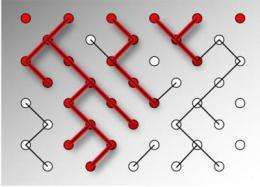Spotting evidence of directed percolation

A team of physicists has, for the first time, seen convincing experimental evidence for directed percolation, a phenomenon that turns up in computer models of the ways diseases spread through a population or how water soaks through loose soil. Their observation strengthens the case for directed percolation's relevance to real systems, and lends new vigor to long-standing theories about how it works. Their experiment is reported in Physical Review E and highlighted with a Viewpoint in the November 16 issue of Physics.
While directed percolation models are handy for describing things as diverse as sand flow and calcium dynamics in cells, no one had managed to find clear, reproducible evidence of the phenomenon in a controlled experiment.
Now a team of physicists from the University of Tokyo, in Japan, and CEA-Saclay, in France, have seen directed percolation in a layer of liquid crystals about a hundredth of a millimeter thick sandwiched between two glass plates connected to electrodes. When they increased the voltage above a threshold, they saw gray spots appearing. A spot could disappear spontaneously but also cause spots to pop up around it, similar to the way a virus can die in one individual after infecting people nearby. The team showed that the system exhibited many of the mathematical hallmarks of directed percolation—convincing evidence that the long-theorized phenomenon occurs in real systems.
More information: Experimental realization of directed percolation criticality in turbulent liquid crystals, Kazumasa A. Takeuchi, Masafumi Kuroda, Hugues Chaté, and Masaki Sano, Phys. Rev. E 80, 051116 (2009) - Published November 16, 2009, Download PDF (free)
Source: American Physical Society



















